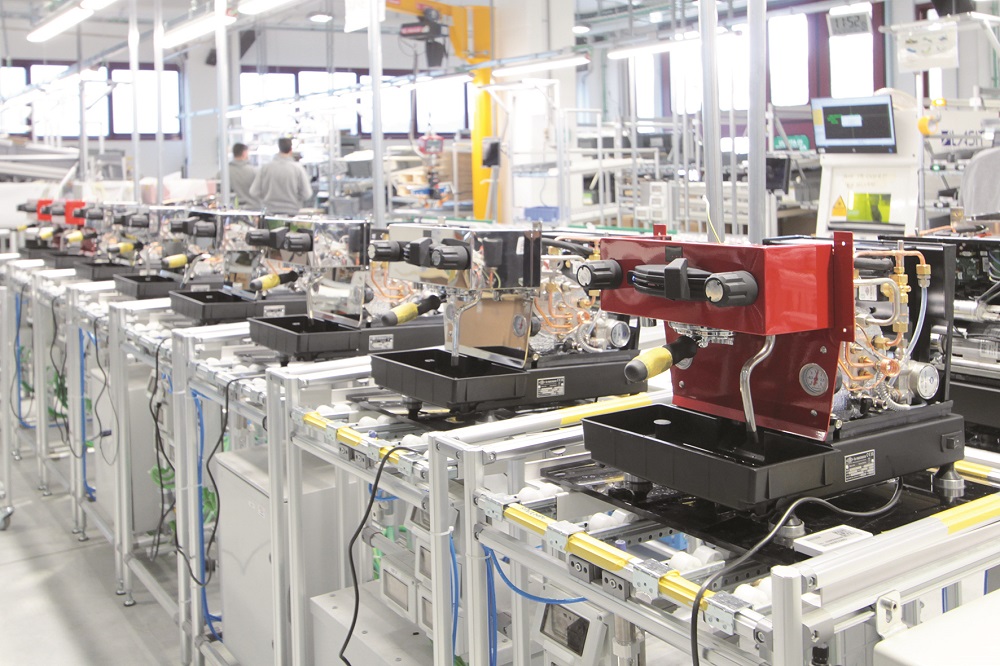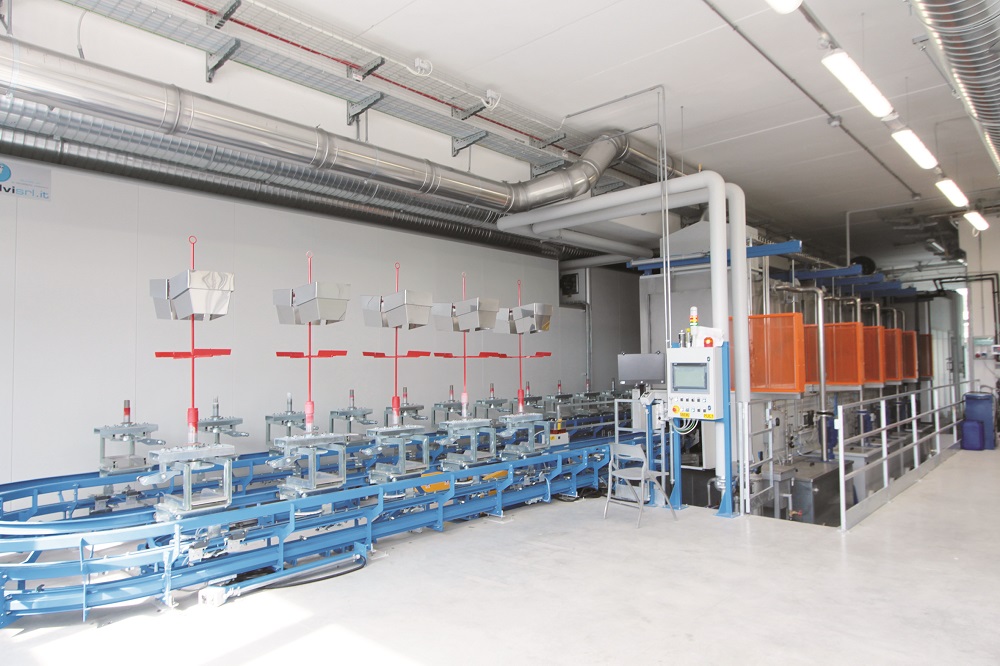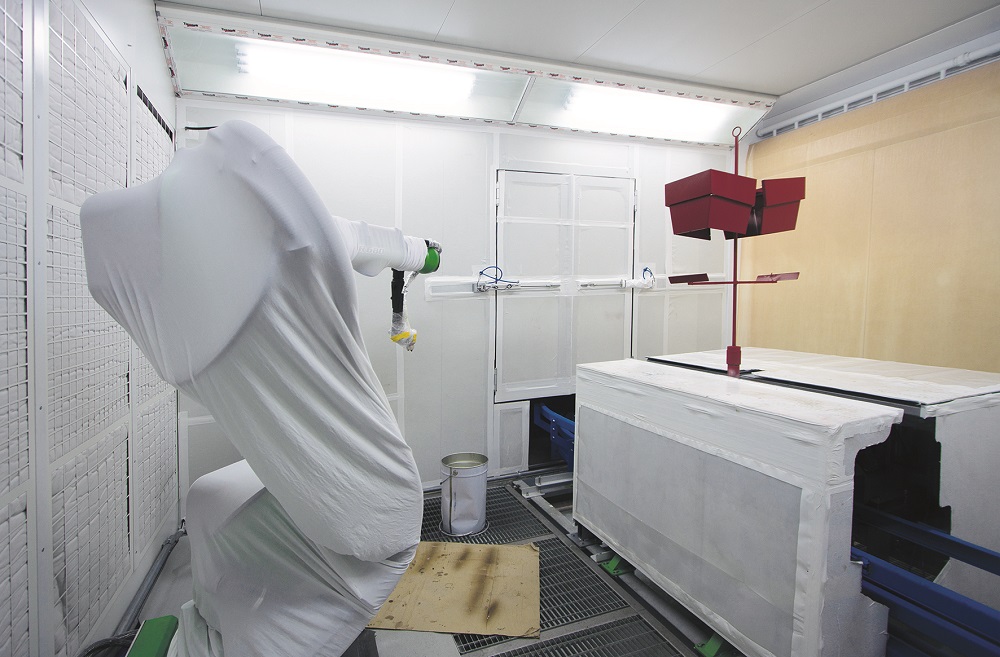A cutting-edge, water-based coating cycle, a new plant designed by Silvi in collaboration with Futura and CMA Robotics, and a water treatment system supplied by Water Energy to optimise environmental sustainability: these were the technical choices made by La Marzocco, an Italian manufacturer of excellence in the industry of high-end professional coffee machines.
In the world of premium coffee, a symphony of elements converges to create an unparalleled taste experience: every detail matters, from the beans’ selection to the grind’s precision. However, one aspect that is often overlooked is the design of the coffee machine. Yet, for coffee lovers who appreciate not only this drink’s taste but also therituality and art of coffee preparation, coffee machines are much more than just tools. La Marzocco stands out in this field as a leading Italian company in the handcrafted production of high-end professional coffee machines.
Founded in the heart of Tuscany in 1927, it has been able to combine craftsmanship and technological innovation to create true works of functional art. Every coffee machine produced by La Marzocco is the result of a relentless commitment to excellence: in addition to guaranteeing superior performance, these objects are designed to enrich the environments in which they are placed with peculiar, refined design. Every detail, from the selection of materials to the choice of finishes, is handled with the utmost attention. Coating plays a crucial role in this constant quest for excellence.
“It is not simply a matter of surface protection but rather a fundamental element in giving our products that touch of style and sophistication that sets them apart,” states La Marzocco’s Purchasing Operations Manager Elena Ciuffi. That is why the company recently decided to equip its production plant, located in Scarperia (Florence, Italy), with a new coating system designed and installed by Silvi Srl
(Peregallo di Lesmo, Monza e Brianza, Italy), specialising in surface treatments for over thirty-five years. The project also involved other leading partners in the coating sector, including Futura Convogliatori Aerei (Robecco Pavese, Pavia, Italy), CMA Robotics
(Pavia di Udine, Udine, Italy,) and Water Energy (San Pietro in Casale, Bologna, Italy). As well as improving coating quality, the resulting plant is also going to speed up production, enabling the company to meet its customers’ requests in a more flexible and timely manner.
An Italian icon around the world: La Marzocco
The history of La Marzocco is a testimony to passion, tradition, and innovation that has deep roots in the heart of Florence. Founded way back in 1927 by two brothers ahead of their time, Giuseppe and Bruno Bambi, this company started out as a small workshop where coffee machines were tailor-made with great care and dedication.
“In the early 1900s, coffee underwent a significant transformation by becoming espresso, i.e. freshly prepared, thanks to innovative espresso machines that helped enhance its qualities,” explains Giada Biondi, Communications Manager at La Marzocco. “For this reason, from its earliest stages, our company has been and still is characterised by its focus on the quality of coffee extraction, recognising the crucial importance of this process for the consumer experience.”
At the same time, what has distinguished La Marzocco from the beginning has been its open and future-oriented mindset
While remaining true to its heritage and Florentine roots, influenced by the Renaissance and the aesthetic concept of Beauty, it has also always welcomed customer feedback in a constructive manner, thus constantly reinventing itself and expanding its horizons. “1939 was an eloquent example of this, as the Bambi brothers decided to market the world’s first horizontal-boiler espresso machine. This innovation improved ergonomics thanks to a more efficient layout of the dispensing units while, at the same time, the absence of a vertical column improved the interaction between baristas and customers, giving them a chance to have a conversation. This originated the convivial, socialising aspect associated with the preparation of coffee in cafés, which became a meeting and sharing opportunity,” Biondi adds. In the following years, La Marzocco continued to evolve by adapting the design of its machines to historical contexts and consumer needs.
“In the 1950s, for example, it embraced the trend of lever machines, which enabled to prepare perfectly creamy coffees thanks to constant, 9-bar pressure for extraction. The period of the post-war economic boom, which corresponded with the entry into the company of Piero Bambi, Giuseppe’s son, marked a crucial moment for La Marzocco’s success: thanks to their refined design and revolutionary technology, including horizontal boilers and the use of stainless steel instead of copper, its machines became synonymous with reliability, durability, and high performance, first locally and then internationally. Especially in the last decade, we have opened key subsidiaries in China, the US, South-East Asia, Scandinavian countries, Australia, the UK, and lately also in the Middle East. Recently, there has been higher and higher demand for La Marzocco machines in Italy, France, and Spain, too: a trend that reflects a growing interest in the quality of coffee and the experience associated with it. Indeed, La Marzocco has espoused the specialty coffee movement – supporting the use of coffee of excellence, rated 80+ by experts – embracing the quest for the highest quality, authenticity, and customisation of the taste experience to reach the target clientele of coffee connoisseurs. We have also contributed to enhancing the barista profession by sponsoring world championships and training courses, recognising its crucial role in transforming coffee from a raw material into an extraordinary drink. Finally, the latest breakthrough occurred in 2015, when La Marzocco launched the La Marzocco Home division, introducing a line of coffee machines for home use.”
Customised production and maximum attention to finishing
 The poduction plant of La Marzocco in Florence.
The poduction plant of La Marzocco in Florence.“Each machine is characterised by recognisable aesthetics, with the predominant use of steel and exposed assemblies, but it is fully customisable to suit customer preferences,” says Ciuffi. “Since 2014, we have experienced exponential growth in our production. Although we currently produce 40,000 units per year, however, we still manage to carry out traditional craftsmanship operations. Our factory has no assembly lines, and each machine is produced with the utmost care and attention by our employees. Over the years, we have forged significant and fruitful partnerships with a number of local suppliers that provide us with pre-formed metal sheets and the mechanical components needed to build our machines.
“Within our production department, we deal exclusively with the welding of boilers, which are the heart of our machines, using automatic robots, as well as the assembly and testing phases – plus, for a few weeks now, the coating step.”
La Marzocco recently decided to insource its coating operations to achieve higher finishing quality and extreme customisation flexibility. “We used to outsource this delicate phase to four companies specialising in contract coating. However, our machines have three to five coated parts each, and, unfortunately, having components painted by different contractors often led to colour-matching and coating uniformity issues. The decision to install a coating line gave us greater control over the process, ensuring that each machine has a uniform, high-quality finish in line with our exacting standards. These are the factors that prompted us to invest in a coating plant,” indicates Ciuffi.
La Marzocco has two production lines: one for producing professional coffee machines and grinders and one for its Home range. “We use six colours for our professional products: white, black, red, yellow, light blue, and metallic silver, as well as some limited editions. For the Home product range, we use a much wider selection of tints,” she notes. “Finishing is an integral part of our quality concept. Every machine must be perfect and tailored to the customer’s specifications. Finishes and custom elements are not just aesthetic details for us but key differentiators. Through constant communication with distributors all over the world, we realised that many of our machines were being adjusted locally to meet customer requirements: therefore, we decided to offer a customisation service ourselves to ensure that each La Marzocco machine is perfectly in line with our customers’ expectations,” says Matteo Urzetta, Purchasing Specialist at La Marzocco.
The new liquid coating plant
The new line installed in February 2024 was designed to coat mainly AISI 304 and 43 steel sheets. The plant features a highstability, power&free inverted conveyor supplied by Futura Convogliatori Aerei, specifically developed to enable the in-line chemical pre-treatment of the parts in a tunnel performing five stages: degreasing, two rinses with mains water, a rinse with demineralised water, and the application of a no-rinse passivating agent. “DN Chemicals (Caleppio, Milan, Italy) developed the chemical products. Currently, it is also helping us assess the possibility of adding a stage for the application of a nanotechnology passivating agent by atomisation to make the pre-treatment cycle even more efficient,” explains Urzetta.
“The application of the nanotechnological passivation product DOLLCOAT SA 116 can in fact improve the anti-corrosion properties and promote the paint adhesion. The main problem to be solved was not the cleaning of the surfaces and their passivation, but the total removal of glue residues used in the peelable films that protect the metal before mechanical processing and pre-treatment. These glues tend to leave residues in parts with folds or more complex geometries, making it necessary to use specific additives for their complete removal", explains André Bernasconi, General Manager of DN Chemicals.
The components are then taken to an air-blowing booth and a drying oven. Afterwards, the automatic paint application phase begins inside three booths equipped with robots supplied by CMA Robotics.
 The coating plant developed by Silvi.
The coating plant developed by Silvi. The coating robot from CMA Robotics applying liquid paint.
The coating robot from CMA Robotics applying liquid paint.“The booths are devoted respectively to the application of the primer, coloured base coat, and clear coat and feature an overspray collection system with a water curtain and a grid bottom with a water collection tank underneath,” illustrates Silvi’s Sales Manager Daniele Fumagalli. “We have created heated flash-off areas and storage buffers between one booth and the other. In addition, there are hot water batteries above the booths and flash-off areas, connected with a heating plant to maintain constant temperatures from 60 to 80 °C. Finally, all the areas that make up the line are pressurised, heated, and air-conditioned.”
“Based on La Marzocco’s requirements, we supplied three different drying ovens in line with the types of paint products used. For primer drying, the company wanted to maintain relatively low temperatures, so we supplied an oven featuring a generator with a hot water battery; for drying the coloured base coat and clear coat, on the other hand, we installed two convection ovens with direct exchange burners because they needed much higher temperatures,” adds Fumagalli.
After coating, the components are finally conveyed into a storage buffer with forced cooling before reaching the unloading area. “Thanks to the high flexibility of the plant, in addition to the technical end-of-shift emptying operations, it is possible to compensate for any differences in process times, also taking advantage of the intermediate storage buffers included in the conveyor’s layout. In addition, the integrated command and control system not only connects all the various stations but also enables to acquire data online and match it with the code assigned to each load bar. This data is then sent to the management system during the unloading phase,” indicates Stefano Gerletti from Futura Convogliatori Aerei.
Water-based clear coat: a major technological challenge
“A small part of our production is powder coated, but over 90% of the components we manufacture are liquid-coated by electrostatic application. Given our strong focus on environmental impact reduction and sustainability, we have chosen to use only water-based paints by relying on Vernici Caldart (Pojana Maggiore, Vicenza, Italy),” states Elena Ciuffi.
“We immediately found the perfect primer and coloured base coat products. The challenge was finding an acrylic two-component transparent top coat that would suit our production. Water-based clear coats are a very innovative product from a technological point of view, but they present several problems, especially related to yellowing over time. Through a process of research and development and after several tests, we overcame these issues and found the right solution to guarantee this product’s high quality and durability. This success certainly represented an important step forward in our quest for high-quality, environmentally friendly finishes.”
Water treatment: a key pillar for environmental sustainability
Based in Bologna (Italy) and specialising in coating water treatment plants, this company supplied three Skimmerflot 3000 series sludge separators, one for each application booth.
“The Skimmerflot units operate by mechanically separating sludge from water, allowing it to emerge and be removed through continuous skimming of supernatant particles, which are sent to special containers equipped with drainage bags,” says Tommaso Ponara, the owner of Water Energy.
“To facilitate the separation of pollutants and the flotation of sludge, Water Energy uses micronised air injected directly into both the feeding circuit and the bottom of the reaction tank.”
“We also installed an automatic demineralisation system in the pre-treatment tunnel with the aim of continuously recirculating the demineralised water used in the last rinsing phase, to maintain the rinsing water’s quality high and prevent the presence of any residues from jeopardising optimum paint adhesion. Water-based paints tend to generate more foam than solvent-based ones as they contain surfactants that keep the product fluid and promote its adhesion to the workpieces during application. However, we believe this can be managed effectively by carefully and precisely identifying the ideal chemical products. Water Energy supplied La Marzocco with various chemicals, including flocculants, denaturants, defoamers, and a pH corrector that also acts as a sanitiser.”
The addition of a flocculant helps lump the sludge produced in the booth and the denaturant prevents the paint from remaining sticky once it comes into contact with water, promoting the formation of micro-flakes that float in the collection tank. This way, the system’s pump can recirculate the water without recirculating the sludge. Afterwards, a flotation system further separates the floating sludge, which is then sent to the Skimmerflot unit, where it is removed and gathered in a dedicated collection tank. This process results in highly solid eluate, reducing residual moisture in the sludge and improving its drainability once collected in bags for disposal.
The system was designed in line with the Industry 4.0 parameters and allows remote monitoring and intervention to solve any problems that may arise, as well as displaying process parameters and any anomalies. “In addition, La Marzocco has joined a Plastic Free programme to further reduce the environmental impact of its business. We supply full drums in exchange for empty ones to encourage reuse and avoid plastic disposal. If any drums are damaged, we are committed to recycling them for other activities, always ensuring responsible waste management and promoting environmental sustainability,” indicates Tommaso Ponara.
Quality, sustainability, and innovation
The new coating line, which has only been operational for a few weeks, is the result of months of work and technological testing by all the companies involved. “We chose Silvi as our partner to design and install our system after careful market research. Its team was willing to support and introduce us to the world of coating, in which we had little experience and technical knowledge. We are also pleased with the collaboration with all the other partners that worked on this project and contributed to its success.”
“Installing this new coating line was a significant step forward for La Marzocco, as it solved many of the logistical and quality related challenges we faced with external contractors. The increase in production year after year and the growing demand for customised finishes for our Home line made this plant essential for maintaining high quality standards and avoiding interruptions in our workflow. “One of our next goals is to obtain B Corp certification as a company committed to assessing and improving its environmental and social performance with the same attention traditionally paid to economic results. This commitment is also reflected in our choice to use water-based paints, the water treatment system we selected, our participation in Water Energy’s Plastic Free programme, and the installation of solar panels,” concludes Ciuffi.